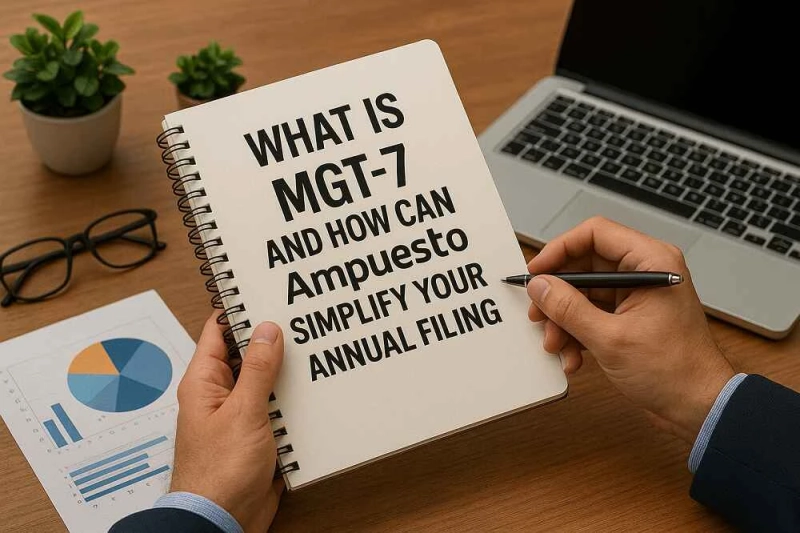Annual compliance is one of the most crucial aspects of running a company in India. Among the multiple filings required by the Ministry of Corporate Affairs (MCA), MGT-7 plays a central role. It is a return that captures the shareholding structure, financial position, and overall corporate health of a company. For many startups and growing businesses, ensuring accurate and timely filing of MGT-7 can feel like a daunting task. That’s where a professional platform like AMpuesto becomes your strategic compliance partner. This blog explains everything about MGT-7 and how AMpuesto simplifies your annual return filing.
Visit: https://ampuesto.in/blog/what-is-mgt-7-filed-for-
Understanding the Purpose of MGT-7
The MGT-7 form is an annual return that every company must file to disclose its key particulars and status to the Registrar of Companies (RoC).
The form serves as a compliance bridge between the company and the MCA, ensuring accountability and transparency.
- Legal Requirement: Filing MGT-7 is mandatory under Section 92 of the Companies Act, 2013.
- Company Snapshot: It records the company’s shareholding, structure, and directorship as of the financial year-end.
- Public Disclosure: Once filed, MGT-7 becomes part of public records accessible through the MCA portal.
- Assists Governance: Regulators, stakeholders, and investors rely on MGT-7 for corporate evaluations.
- Penalty Avoidance: Delays in MGT-7 attract penalties of ₹100 per day.
- Required Even for Dormant Companies: Unless struck off, every registered entity must file MGT-7.
With AMpuesto, companies can avoid compliance lapses and file their MGT-7 without confusion or delay.
Who Must File MGT-7?
Understanding who is legally bound to file MGT-7 is the first step toward staying compliant.
Nearly all registered companies in India must file MGT-7, barring a few exceptions.
- Private Limited Companies: All Pvt. Ltd. companies must file MGT-7, irrespective of turnover or activity.
- Public Limited Companies: Filing is compulsory for both listed and unlisted public companies.
- One Person Companies (OPCs): File a simplified version called MGT-7A.
- Small Companies: These can also use MGT-7A, a shorter version introduced for ease.
- Section 8 Companies: Even charitable entities must comply.
- Foreign Companies with Indian Branches: Required in some special scenarios.
With AMpuesto, you get clarity on which form to file — MGT-7 or MGT-7A — and support in completing the process correctly.
Due Dates and Penalties for MGT-7 Filing
Missing the deadline for MGT-7 can lead to significant penalties. Understanding the due dates helps you stay on track.
MGT-7 must be filed annually, within a defined timeline after the end of the financial year.
- Due Date: Within 60 days from the date of holding the Annual General Meeting (AGM).
- Financial Year Consideration: Typically ends on March 31.
- Last Filing Date: For most companies, this falls around September 29 or October 30.
- Late Filing Penalty: ₹100 per day of delay.
- Maximum Cap: No upper limit — prolonged delays can result in high penalties.
- AMpuesto Reminder Service: Automatic reminders help you avoid missing deadlines.
By working with AMpuesto, you get timely alerts and full compliance support to ensure MGT-7 is always filed on time.
Information Required to File MGT-7
To file MGT-7, companies must submit detailed information about their structure and operations for the financial year.
Here’s what you’ll need to prepare before submission.
- CIN and PAN of the Company
- Principal Business Activities
- Details of Shareholding Pattern
- Board of Directors’ and Key Managerial Personnel Data
- Debenture Holders and Share Transfers
- Compliance Certificate (MGT-8, if applicable)
- List of Meetings Held During the Year
With AMpuesto, all your company data is organized and validated before form submission to ensure an error-free MGT-7 experience.
Step-by-Step Guide to Filing MGT-7
Filing MGT-7 involves multiple steps, and errors can result in rejections or penalties.
Here’s how AMpuesto simplifies every stage:
- Step 1: Company provides key financial and structural data.
- Step 2: AMpuesto verifies eligibility for MGT-7 or MGT-7A.
- Step 3: Professionals fill and validate the form using MCA utility.
- Step 4: Attach supporting documents like MGT-8 (if applicable).
- Step 5: Apply DSC (Digital Signature Certificate) of the director.
- Step 6: Upload the form on the MCA portal.
- Step 7: SRN (Service Request Number) is generated for future tracking.
With AMpuesto, every step is professionally managed for a smooth and accurate MGT-7 filing process.
Difference Between MGT-7 and MGT-7A
Understanding which version of the form to file is essential for accurate compliance.
MGT-7A is a simplified return introduced to reduce the compliance burden for smaller companies.
- MGT-7: Applicable to all companies except OPCs and small companies.
- MGT-7A: Used by One Person Companies and small companies.
- Information Difference: MGT-7A requires fewer details.
- Filing Experience: Quicker and more streamlined.
- Attachments: Similar but with relaxed requirements.
- Penalties: Same penalty structure applies to both forms.
AMpuesto helps identify the right form for your business and assists in ensuring you don’t file the wrong version.
Common Errors in MGT-7 Filing
Even experienced companies make mistakes that can lead to notices or rejection of filings.
Avoid these common errors with help from AMpuesto:
- Incorrect Financial Year: Ensure correct date range is selected.
- Wrong Director Details: Mismatched DIN or tenure info can cause issues.
- Missed Attachments: Forgetting MGT-8 or shareholding summary is a red flag.
- Expired DSC: Leads to failed submission.
- Mismatch with MGT-9 or AOC-4: All filings must match.
- Wrong Form Version: Filing MGT-7 instead of MGT-7A, or vice versa.
AMpuesto ensures all fields are accurately filled, documents are verified, and the correct form version is used.
Why MGT-7 Is Crucial for Corporate Governance
Filing MGT-7 is more than a legal requirement—it reflects your commitment to good governance.
The data submitted through MGT-7 enhances your company's transparency and credibility.
- Public Disclosure: Shows your company has nothing to hide.
- Investor Trust: Accurate returns improve your valuation and investor confidence.
- Operational Transparency: Details like board meetings, KMP, and ownership show internal clarity.
- Compliance Culture: Regular filing helps build a culture of compliance.
- Future-Proofing: Reduces risk during mergers, funding, or audits.
- Director Liability Protection: Keeps directors from being penalized for defaults.
With AMpuesto, you align your filing with best governance practices.
How AMpuesto Makes MGT-7 Filing Easy
Handling MGT-7 on your own can be time-consuming and risky.
Here’s how AMpuesto simplifies the entire experience:
- Dedicated Compliance Experts
- Document Review & Error Checking
- DSC Application or Renewal Support
- Timely Reminder Alerts
- Affordable Pricing Plans
- End-to-End Filing & Acknowledgment Tracking
- PAN India Service with 100% Online Support
With AMpuesto, your annual filing is not just compliant—it’s stress-free and streamlined.
Conclusion
Filing MGT-7 annually is not just a statutory requirement—it’s a reflection of your company’s transparency, structure, and financial integrity. Non-compliance or inaccuracies can lead to heavy penalties and damage your business credibility. This is where AMpuesto becomes your trusted compliance partner, helping you file MGT-7 accurately, on time, and with complete documentation. Whether you are a startup, a small company, or an established enterprise, AMpuesto ensures your annual return filing is smooth, compliant, and professional. So why take risks? Let AMpuesto handle your MGT-7 filing with expertise and efficiency.


